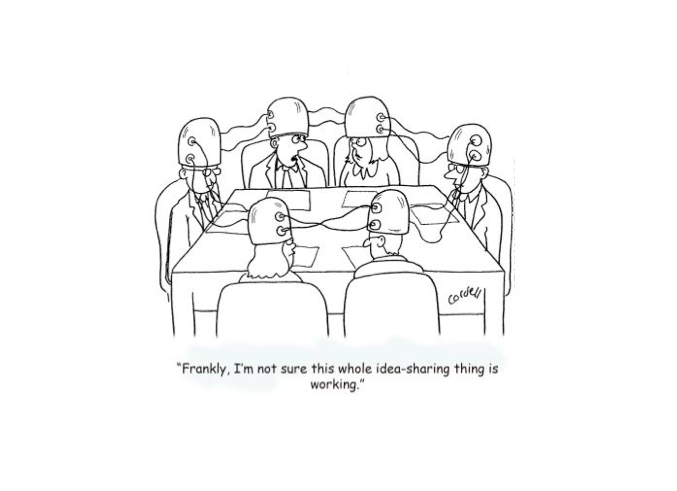
“Brainstorming isn’t effective”…how to improve it?
UX Magazine recently published an article outlining solutions to the problem of ineffective brainstorming:
http://uxmag.com/articles/getting-fruitful-collaboration-instead-of-stale-groupthink
To save you the time of clicking on the link, here’s a quick summary:
1. Give time to think to your attendees
“Provide as much information about the situation as you can before the work session.”
“Even if it’s sent in an email without context, you’ve introduced the topic and given the seeds of ideas a chance to germinate.”
2. Set expectations
“Do the work of setting a specific goal for the session. The team will [reach this goal] by [this time] in order to [create this future impact].”
“This kind of statement will also help identify the immediate needs as well as those issues that can be deferred.”
3. Communication
“During user research, we practice techniques, which ensure that we gather accurate meaning from participants’ statements while tailoring our communication style to match our audience.”
4. Don’t talk at the same time
“Give your group sticky notes to put ideas, questions, or assumptions on the board.”
5. Make conflict constructive
“You have to accept and build upon whatever your partner has done.An exercise for constructive conflict: have everyone write an idea on paper. Once all are submitted, select one from the pile. Then take turns with each member of the group expanding on the idea, or adding detail. Keep going around the table with each person building on the concept until the well is dry.”
Seeing as brainstorms are a daily routine here at Yu Centrik, I decided to engage a few members of the team to see what they think about these suggestions:
Louis-Thomas
“A lot of thinking here is based on the premise that some people need time to think or time with themselves (introverts). This is a personality trait, it is harder to ask people to change that. Better deal with it and adapt the group thinking strategy to work with that!”
Jay
“What I think is missing from this is the amount of work and great ideas in design thinking to actually improve the group collaboration process. In the “Make Conflict Constructive” section, the post talks about a little activity where you write things down. There are a lot of different types of systematic approaches to elicit creative collaboration from affinity diagramming/the KJ method all the way to bodystorming, brainwriting, design charettes, and much more!”
Joëlle
“I would also raise the question of who should be part of the session? Brainstorm is to encourage creativity; is everyone creative and does everyone bring valid input? Any thoughts?”
Dave
“I strongly agree with #1 – My best ideas usually take some time to “come to the front of my mind”, and I’ve thought of much better stuff after the brainstorm session is over. “
Marcio
“I believe “setting the expectations” is a key element in all this. We need to set the expectations right because it’s not necessarily always “find a solution to the problem”. Sometimes the “problem” might need one or more brainstorming sessions as people, as Dave said, might need more time to think before they can bring more solid ideas to the discussion. We have to be wise and know when a specific problem needs more than one collaborative work session instead of thinking that one brainstorming session is all it takes to find the right answer.
Problems that require brainstorming sessions are usually complex, otherwise a session like this wouldn’t be necessary, right? If it’s a complex problem, what makes us think that a single meeting would be enough, even with the smartest people around the table?”
Natalie
“The “social collaboration space” point in the article is worth mentioning. It not only sets everyone up for the workshop so they come in more informed and alert (especially if includes a little preparation/research task), but it allows for interesting ideas and discussion afterwards. In this way the “time to think” and “introverts” issues are addressed. I had once seen the best idea appear the day after the session in the social collaboration space.”
Karine
“Preparation is key but it takes time and sometimes even the facilitator interrupts his team…So “everybody has to make an effort” 🙂 I agree with Dave: point #1 is essential to be constructive. Everybody has to be a little bit prepared.”
Image source: Original artist – Reproduction rights obtainable fromwww.CartoonStock.com
0 Comment(s)